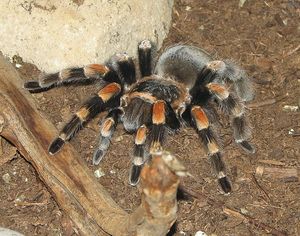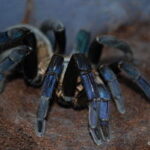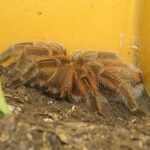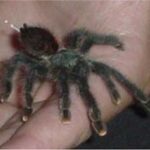Mexican Red Knee tarantulas are among some of the most popular pets owned by arachnid enthusiasts, as this species is notorious for being extremely docile. Mexican Red Knee tarantulas are easily recognizable by the orange/red and white bands around their legs. For first-time tarantula owners, this species is highly recommended, as are a low maintenance pet that is easy to handle.
The Mexican Red Knee is native to desert and scrubland areas on the Pacific side of Mexico. It is a terrestrial species, so the spider’s enclosure should be long rather than tall. Be sure to provide your tarantula with plenty of room to burrow, as well as a hide such as a hollow log.
Mexican Red Knees are commonly used in horror movies, as they are very docile and unlikely to kick urticating hairs or bite. While they may appear menacing, these spiders are actually very sweet and are perfect if you are looking for a species that can be handled. However, spiders have no need or desire to be handled, so your Mexican Red Knee will be perfectly content living in their enclosure if you decide against playing with your spider.
Like all other species, the Mexican Red Knee has a very large abdomen. The abdomen contains all of the spider’s internal organs, and is the most fragile part of the body. If you decide to handle your tarantula, be sure not to hold it too high above the ground. Even a short fall can cause the tarantula’s abdomen to rupture, which is nearly always fatal. Though Mexican Red Knees are very docile, be sure to watch for clues that the tarantula is distressed or angry with being handled. If the spider rears up on its hind legs, it is trying to scare you off and may bite or fling hairs. Hairs get embedded in the skin and cause extreme irritation.
The Mexican Red Knee has one of the longest lifespans of any species, with females living as long as 30 years. This species reaches an adult legspan of roughly 5 inches.
Mexican Red Knees will eat any invertebrate they can easily overpower, with crickets, grasshoppers and meal worms all serving as great choices. If you purchase your tarantula as a spiderling, pinhead crickets will provide adequate nutrition. Spiderlings will acquire hydration through the water in their prey, but a small, shallow waterdish can be placed in enclosures for tarantulas with a legspan of 3 inches or more.
The inside of your Mexican Red Knees enclosure should be kept between 75 and 90 degrees Fahrenheit, and the humidity should be kept between 75% and 80% For spiderlings, simply mist the vial or pill bottle once per week to provide humidity.
Like all species, Mexican Red Knees molt in order to grow. Your tarantula may refuse food for an extended period of time prior to molting. This time may range from as short as a week to as long as a month as the spider prepares to grow. The tarantula will lay down flat on its back and may appear dead while molting. Do not disturb the spider while it is molting, as its new exoskeleton will be extremely fragile. After the spider has successfully molted, remove it’s old exoskeleton and leave the spider alone for a week so that the new exoskeleton has time to harden. Do not feed the spider during this time, as it will be so fragile even a cricket can seriously injure or even kill it.
References:
http://www.petbugs.com/caresheets/B-smithi.html






